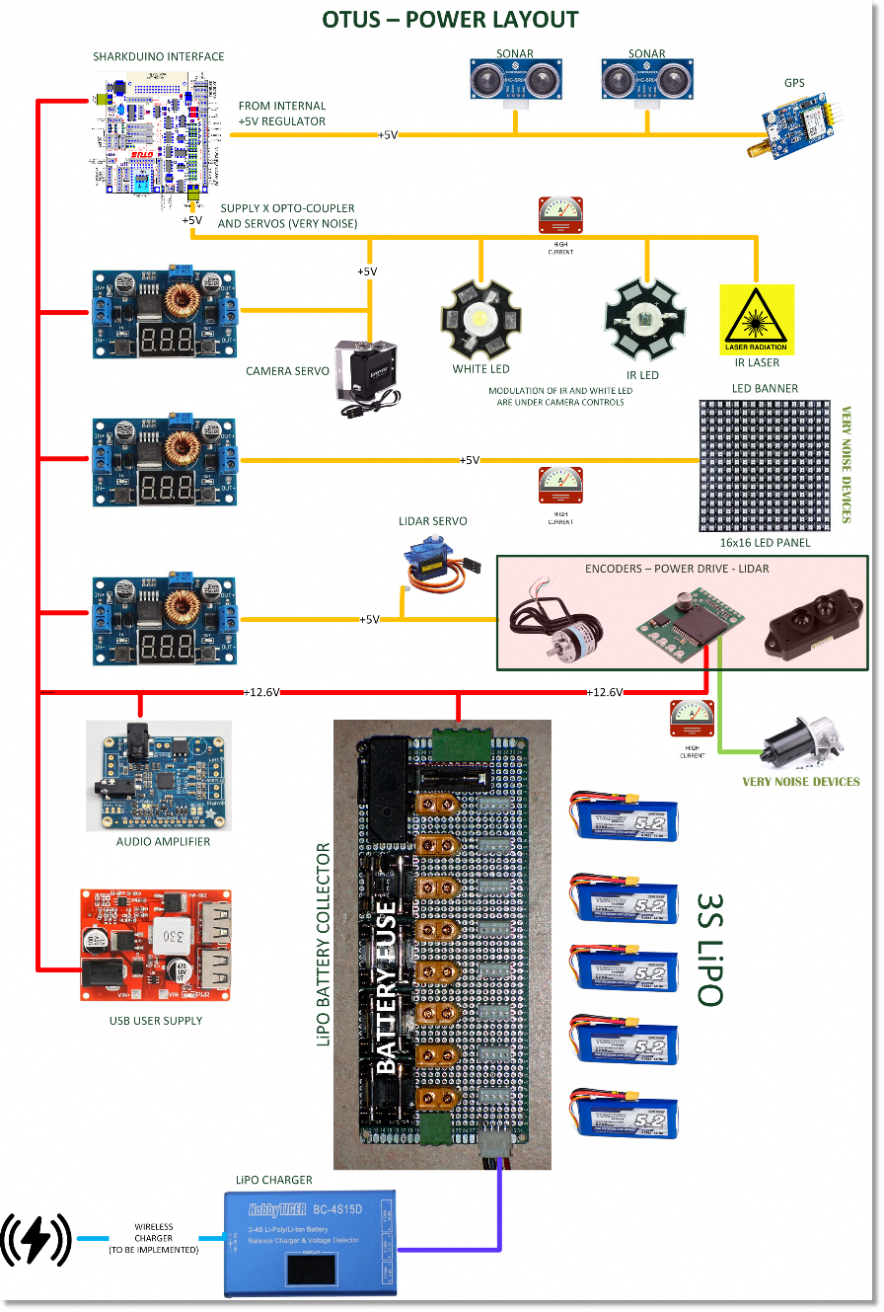OTUS - The Power Supply
OTUS é alimentato a batterie ricaricabili a 3 celle del tipo litio-polimero.
Con batterie a tre celle abbiamo una tensione di lavoro di 12.6V, quando cariche e di 11V quando scariche.
La tensione di batteria viene erogata direttamente ad i motori e all'amplificatore audio mentre per tutti gli altri dispositivi viene convertita a +5V con opportuno alimentatore switching.
Gli alimentatori switching utilizzati sono i classici modelli orientali da 5A (max), molto economici, rumorosi ma affidabili.
Si 'e scelto di utilizzarne 3 da distribuire sui vari dispositivi. Questa scelta si é rilevata ottimale in quanto la conversione avviene sempre vicino al carico e con una riduzione di mutui disturbi.
Qui sotto possiamo vedere uno schema a blocchi della distribuzione dell'energia.
OTUS is powered by 3-cell rechargeable lithium-polymer batteries.
With three-cell batteries we have a working voltage of 12.6V when charged and 11V when discharged.
The battery voltage is supplied directly to the motors and to the audio amplifier while for all the other devices it is converted to +5V with a suitable switching power supply.
The switching power supplies used are the classic oriental models of 5A (max), very cheap, noisy but reliable.
We have chosen to use 3 to distribute on various devices. This choice was found to be optimal as the conversion always takes place close to the load and with a reduction of mutual disturbances.
Below we can see a block diagram of the energy distribution.

Per l'impiego delle batterie LiPO si é costruito un circuito che le mette in parallelo e che ne permette la ricarica.
É presente anche un circuito per l'accensione e spegnimento, che avviene tramite due pulsanti.
Questa scelta é stata dettata dalla necessitá di poter eseguire auto-accensioni ed auto-spegnimenti da parte dell'elettronica di bordo.
É anche presente un lettore di corrente ad effetto Hall per avere una lettura dei consumi in tempo reale.
SCHEMA ELETTRICO COLLETTORE LIPO
For the use of LiPO batteries, a circuit has been built that puts them in parallel and allows them to be recharged.
There is also a circuit for switching on and off, which takes place via two buttons.
This choice was dictated by the need to be able to carry out self-starts and self-shutdowns by the on-board electronics.
There is also a Hall effect current reader for reading consumption in real time.
RICARICA BATTERIE SENZA FILI
Le batterie vengono caricate da uno opportuno modulo (Qui la pagina del prodotto) che ne controlla il bilanciamento e ne effettua la carica.
Questo modulo ha una bassa corrente di carica, questo risulta molto utile per non stressare eccessivamente le batterie.
Questo modulo ha una bassa corrente di carica, questo risulta molto utile per non stressare eccessivamente le batterie.
Occorre considerare che il robot normalmente staziona nella sua postazione di parcheggio e qui riceve in automatico una carica tramite trasmissione di energia senza fili.
In pratica non si sposta dalla sua postazione se non per un lavoro da eseguire o per un evento di allarme, conseguentemente é qui che passa la maggior parte del tempo e da qui la necessitá di una bassa ricarica.
In pratica non si sposta dalla sua postazione se non per un lavoro da eseguire o per un evento di allarme, conseguentemente é qui che passa la maggior parte del tempo e da qui la necessitá di una bassa ricarica.
Il trasmettitore di energia senza fili é di commercio (Qui la pagina del prodotto) ed il ricevitore puó erogare 12V 2A, piú che sufficienti per la nostra ricarica.
Quello che si é rilevato veramente problematico é il posizionamento del robot al caricatore senza fili.
Quello che si é rilevato veramente problematico é il posizionamento del robot al caricatore senza fili.
In pratica per avere un buon accoppiamento di energia occorre una certa precisione e questo non é stato facile.
A nostro sfavore la dimensione del robot ed il ristretto campo di azione del caricatore senza fili.
A nostro sfavore la dimensione del robot ed il ristretto campo di azione del caricatore senza fili.
WIRELESS BATTERY CHARGING
The batteries are charged by a suitable module (Here the product page) which checks their balance and charges them.
This module has a low charge current, this is very useful for not excessively stressing the batteries.
It should be noted that the robot normally stays in its parking position and automatically receives a charge there by wireless energy transmission.
In practice, it does not move from its position except for a job to be performed or for an alarm event, consequently this is where most of the time passes and hence the need for a low recharge.
The wireless energy transmitter is commercially available (Here the product page) and the receiver can supply 12V 2A, more than enough for our recharge.
What has been found to be really problematic is the positioning of the robot on the wireless charger.
In practice, in order to have a good energy coupling, a certain precision is needed and this has not been easy.
To our detriment the size of the robot and the narrow range of action of the wireless charger.

